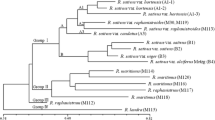Abstract
The Waxy gene (Wx) encodes the granule-bound starch synthase responsible for the synthesis of amylose in rice (Oryza sativa). Recently, a polymorphic microsatellite sequence closely linked to the Wx gene was reported. To determine whether polymorphism in this sequence correlates with variation in apparent amylose content, we tested an extended pedigree of 92 current and historically important long-, medium- and short-grain US rice cultivars representing the efforts of many breeders over more than 80 years. Seven Wx microsatellite alleles were identified which together explained 82.9% of the variation in apparent amylose content of the 89 non-glutinous rice cultivars tested. Similar results were also obtained with 101 progenyof a cross between low- and intermediate-amylose breeding lines. An additional, unique microsatelliteallele, (CT)16, was detected in one glutinous cultivar,CI 5309. However, the other glutinous cultivars,Calmochi 101 and Tatsumi mochi, were in the (CT)17 class along with three other cultivars that contained15–16.5% amylose.
We sequenced a 200-bp PCR-amplified fragment containing the CT microsatellite and the putative 5′ splice site of the Wx leader intron from a subset of 42 cultivars representing all eight microsatellite alleles. All of the cultivars with 18% or less amylose had the sequence AGTTATA at the putative leader intron 5′ splice site, while all cultivars with a higher proportionof amylose had AGTTATA. This single nucleotidesubstitution could also be assayed by AccI digestion of the amplified fragment. Overall, this single nucleotide polymorphism could explain 79.7% of the variation in the apparent amylose content of the 89 non-glutinous cultivars tested. Interestingly, cultivars in the (CT)19 microsatellite classes that differed substantially in amylose content still showed the correlation between this G-T polymorphism and apparent amylose content. The G-T polymorphism at this site was not, however, able to explain the very low amylose contents of the three glutinous cultivars tested, all of which had the sequence AGTTATA.
Similar content being viewed by others
Author information
Authors and Affiliations
Additional information
Received: 31 July 1996 / Accepted: 22 November 1996
Rights and permissions
About this article
Cite this article
Ayres, N., McClung, A., Larkin, P. et al. Microsatellites and a single-nucleotide polymorphism differentiate apparentamylose classes in an extended pedigree of US rice germ plasm. Theor Appl Genet 94, 773–781 (1997). https://doi.org/10.1007/s001220050477
Issue Date:
DOI: https://doi.org/10.1007/s001220050477




